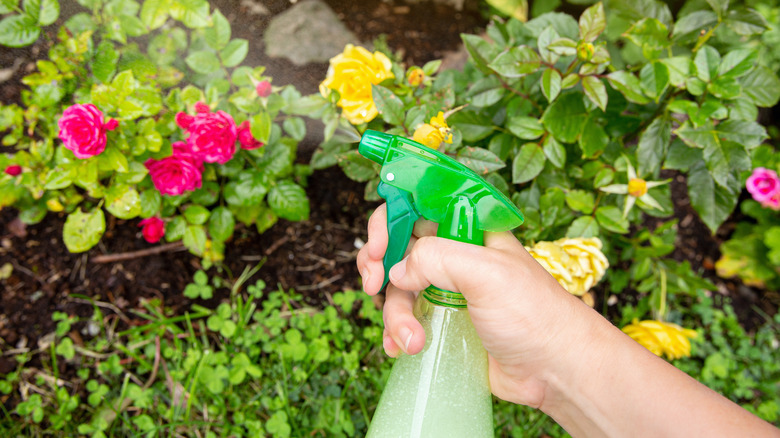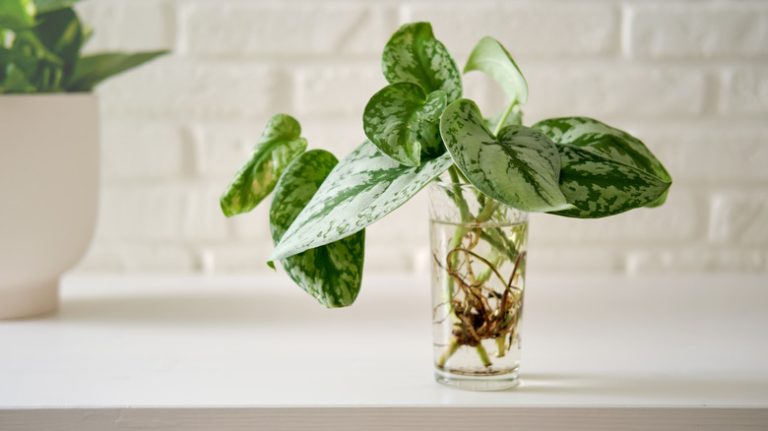When you dive into your gardening work, reach for a bottle of castile soap. This isn’t just soap; it’s your multi-tool for various garden issues. Whether you’re dealing with powdery mildew, cleaning your gardening tools, or fighting off pests, castile soap has your back. But let’s talk about why this soap is such a standout. It’s eco-friendly to its core. Crafted entirely from natural oils, it’s vegan and biodegradable, fitting right into a sustainable gardening routine. In many cases, you don’t have to worry about harmful stuff like parabens or sulfates either; many brands offer clean and safe formulations for both humans and plants. However, don’t let your guard down and vigilantly check the ingredients when shopping around.
If you’d rather make your own, here’s how it’s done: Mix olive oil with an alkali, usually lye, and voilà— you’ve got a mild, moisturizing soap loaded with oleic acid. Now, if you choose to purchase a pre-made solution, you’ll notice some modern twists to the traditional formula. Manufacturers often blend other plant-based oils to amp up the soap’s features. Coconut oil, for example, lends a nice, frothy lather, while hemp oil adds a soothing effect. Some soaps even include essential oils like lavender or tea tree for their special benefits to plants. So, the next time you find yourself mulling over various garden challenges, remember that castile soap can be your go-to green solution. Here’s how.
It removes powdery mildew
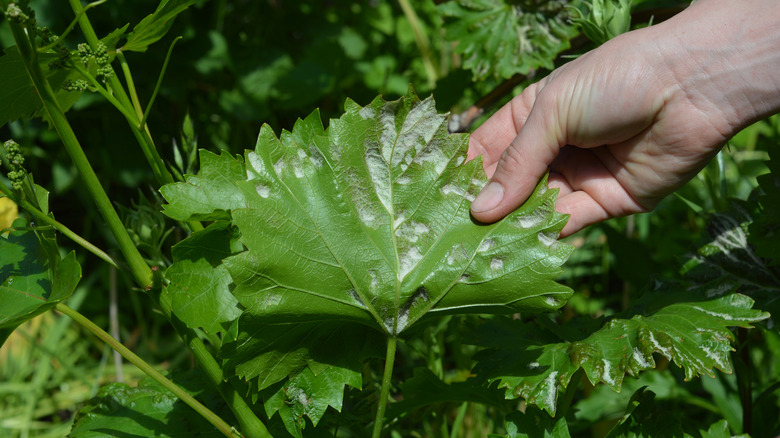
Addressing the issue of powdery mildew can be daunting, especially when you see its white, powdery residue marring the appearance of your beloved plants. This fungal disease isn’t just unsightly; it poses a real threat to your plants’ health. Powdery mildew causes leaves to weaken or fall prematurely. If left unchecked, it can lead to poor fruit development and stunt crop growth, essentially sapping the vitality of your garden. The good news is that your choice of castile soap as a remedy is both effective and eco-friendly.
Simply fill a spray bottle with your gallon of diluted castile soap and aim it at the specific regions of the plant suffering from the mildew. Before you embark on a full-scale application, running a patch test is critical. Choose a leaf or a small section and apply the soap solution. Wait 24 to 48 hours to monitor any negative reactions, like leaf discoloration or wilting. If all is well, be sure to spray the mixture on the affected areas. If you’re dealing with a serious outbreak, intensify the formula by adding more potassium bicarbonate and castile soap to the mixture. Also, if you spot any sections of your plants that are beyond saving due to disease, clip those off and dispose of them away from your garden area. It’s a surefire way to stop the fungus in its tracks. Timing is also crucial in this treatment. Spray it in the early morning to prevent the growth of fungal spores associated with evening watering.
It can be used to wash plants
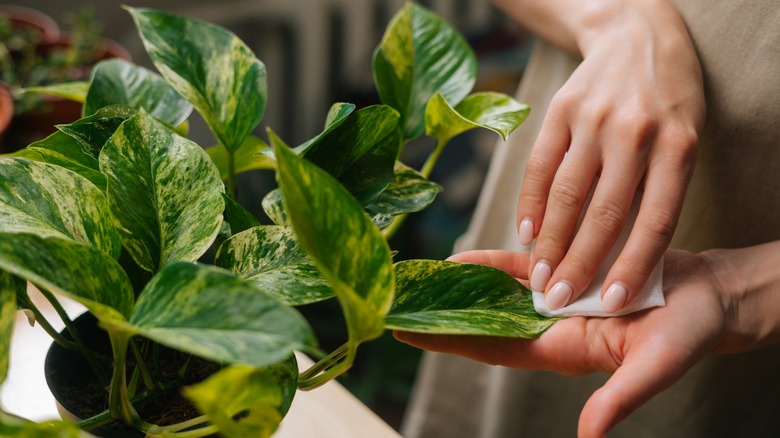
Let’s now talk about giving your plants a spa day — in a practical way. Accumulated dust and dirt on plant leaves can be more than just an eyesore; they can block sunlight and mess with the plant’s ability to photosynthesize. But here’s where castile soap comes in handy again: It excels in cleaning because it serves as a surfactant, which is just a fancy way of saying it disrupts the attachment of dirt and microbes to surfaces. When you use it for cleaning, you’re not merely smearing grime; you’re actually lifting and removing it. This ensures a deeper, more effective clean. A gentle spray made from castile soap can be your go-to remedy. Mix 1 tablespoon of castile soap with some water, pour that into a spray bottle, and you’re armed for action.
Spray this solution generously onto your plants’ leaves, and don’t forget those hard-to-reach undersides where dirt loves to hide. What you’re doing here is setting up a cleaning routine that, when done periodically, can seriously uplift your plants’ overall well-being. The castile soap works to dissolve the grime, enabling your plants to breathe easier and soak up that much-needed sunlight for photosynthesis. After you’ve made sure to coat the leaves thoroughly, it’s rinse time. Use clean water to wash off the soap, ensuring there’s no residue left. You certainly don’t want any lingering soap, as it could lead to other problems.
It acts as a multi-surface cleaner for garden tools
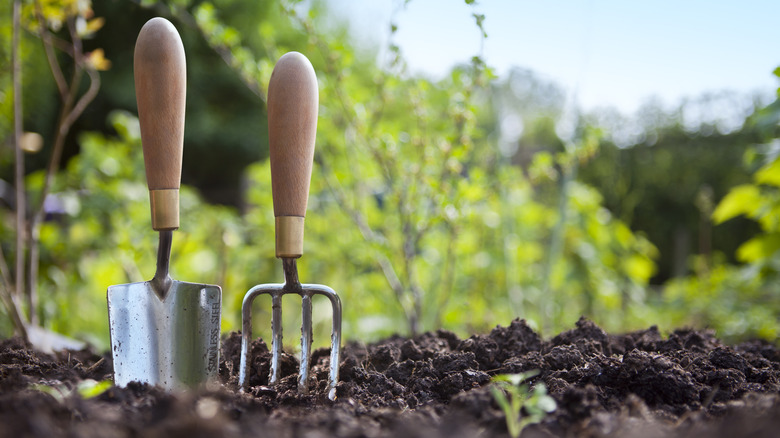
Cjp/Getty Images
Let’s pivot to another often-overlooked aspect of gardening — keeping your tools in tip-top shape, especially those you use for pruning. You rely on these tools to cultivate a lush garden, but did you know they can also harbor disease-causing bacteria or even become rusty over time? Regular cleaning isn’t just a good practice; it’s important to curb the spread of plant viruses and other nasty stuff. We’ve discussed using castile soap for cleaning plants, but did you know it’s also an exceptional cleaner for your tools? For an effective, environmentally friendly clean, combine hot water and castile soap. Encountering stubborn grime? Immerse your tools in this mixture and let them soak. This loosens any hard-to-remove material, making your subsequent scrub much more effective.
Its non-corrosive qualities make castile soap uniquely suited for cleaning garden tools. Thanks to its plant-based formula, it cleans without promoting rust, which is more than can be said for many chemical cleaners out there.
It washes plant pots effectively
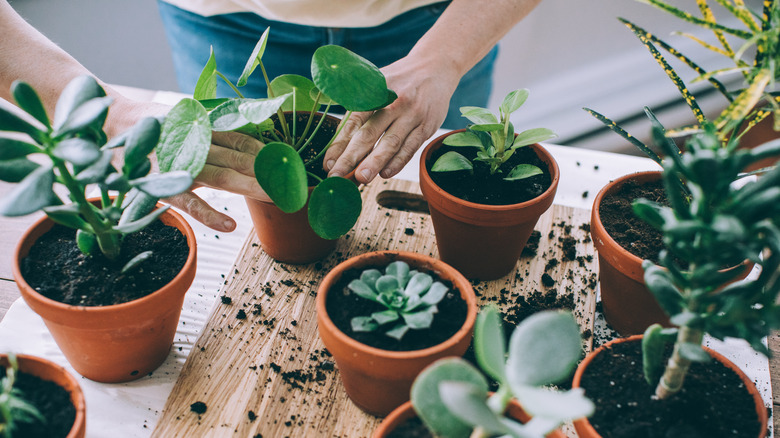
Mmeemil/Getty Images
Over time, plant pots — whether made of plastic, ceramic, or terracotta — can gather disease and fungi. But you may not realize that these pots can become hotspots for diseases and fungi over time. And here’s a heads-up — when you repot, you risk transferring those unwelcome pathogens to your new plants. This is especially true for terracotta pots. It is an excellent material for nurturing plants that prefer well-drained soil. However, since it’s porous, it can harbor bacteria and other tiny particles within its walls. So, how do you deal with this? Castile soap can work wonders.
Simply fill a basin with hot water, add a few drops of soap, and let your plant pots soak for up to 20 minutes. Ensure all parts of your pots are fully covered — this is especially important if you have irregularly shaped or decorated pots with hidden corners where dirt can accumulate. Then scrub them with a brush to remove any residual grime or soil. Want to make your cleaning solution even more potent? Introduce a small amount of white vinegar to your soap and water mix. It’s like adding a turbo boost to your cleaning regimen, helping dissolve mineral buildup more effectively and neutralize bacteria. Just remember, a small amount will do; you don’t need to go overboard.
It works as an herbicide spray
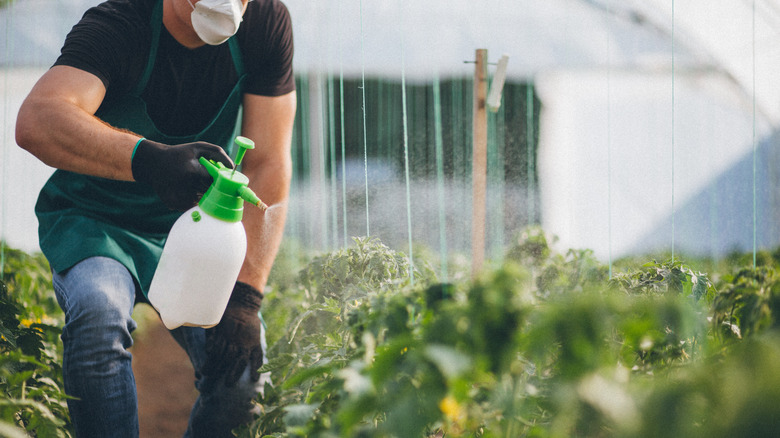
South_agency/Getty Images
Switching gears to the topic of pests, let’s be clear: Insects such as aphids, spider mites, and whiteflies aren’t just annoying. They are full-blown saboteurs in your garden. Aphids and whiteflies suck out cell contents, leading to yellow, distorted leaves. They are also known for transmitting plant diseases. Spider mites, on the other hand, create webbing that can smother your plants. Over time, these issues can escalate from minor annoyances to potential plant death. So, getting rid of these critters isn’t optional; it’s essential for a healthy garden.
Castile soap is an unsung hero in this battle. Its fatty acids don’t just cleanse; they get under the skin of these pests, literally. When the soap comes into contact with them, it breaks down their exoskeletons, leading to fatal dehydration. Store-bought insecticides are an option, but making your soap spray at home is both cost-effective and simple.
Mix 1 tablespoon of castile soap with water to whip up your pest-fighting concoction. Fill a spray bottle with this blend, and you’re ready to reclaim your garden. But wait, there are a couple of caveats. First, always conduct a patch test on your plants to ensure there’s no adverse reaction to the soap. After the pests have met their soapy doom, rinse your plants to remove any soap residue. Failure to do this could lead to leaf damage.
It prevents rabbits and other critters from eating plants
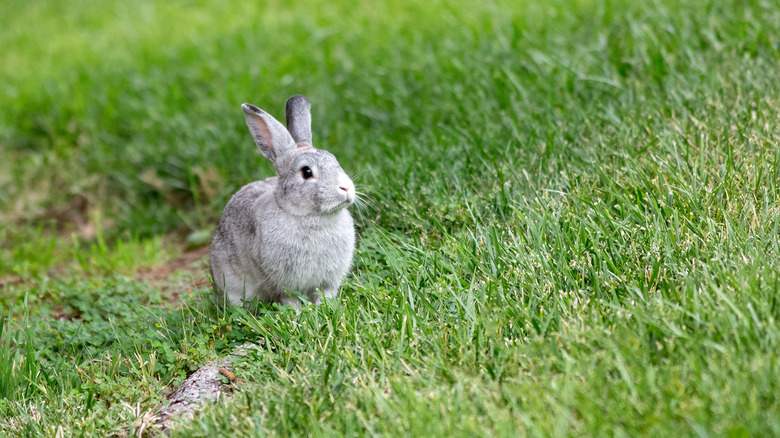
Zeiss4me/Getty Images
While you may love having a local wildlife presence, the love isn’t always reciprocal regarding your garden. Rabbits, deer, and even birds can treat your carefully cultivated plants like an all-you-can-eat buffet. Let’s face it, fencing and netting can be unsightly and expensive, but here’s where castile soap shines once again. Mix a few drops of castile soap with a gallon of water and a sprinkle of cayenne pepper, and apply the mixture around the plants to create a scent barrier that many animals find off-putting.
Amp up the repellent power by adding a few drops of essential oils. You can experiment with varying oils to keep different animals at bay. Lavender, for example, may work wonders against rabbits, while citronella could be your best bet against various insects. This dual-benefit action is nothing short of brilliant — you keep intruders away and simultaneously enliven the sensory experience of your garden. Moreover, because your mixture is so targeted, you don’t risk driving away useful critters, like bees, that actually contribute positively to your garden’s ecosystem.
This olfactory deterrent is a humane way to guide creatures away, avoiding crueler deterrents like traps that can harm animals. It also reduces the need for physical barriers that can impede your garden’s aesthetic appeal. Moreover, since many essential oils have additional antifungal and antibacterial properties, you’re repelling pests and giving your plants an added layer of protection against diseases.
Increases water supply for plants
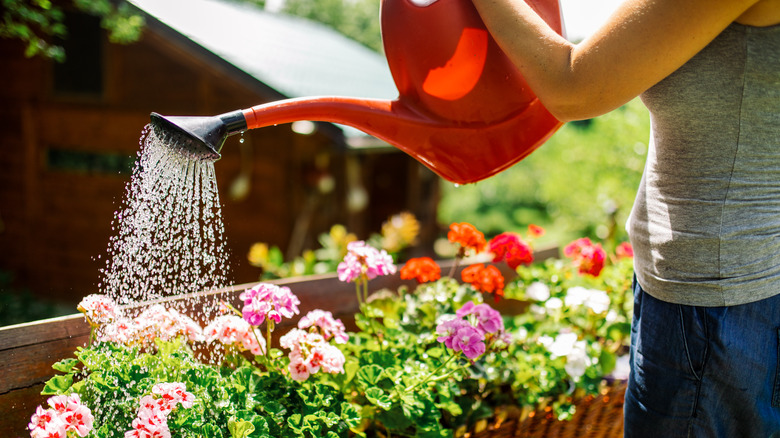
Miljko/Getty Images
You’ve probably noticed that soil can get dry for many reasons. It could be the scorching heat of summer, low humidity levels, or simply the type of soil you’re using. Especially in container gardening, some potting mixes are notorious for becoming hydrophobic when they dry out, refusing to absorb water effectively. That’s where castile soap comes into play as an unexpected yet efficient solution.
So, what’s happening on a molecular level when you add castile soap to your watering routine? It all boils down to surfactants, which are the active agents in the soap. As they combine with water molecules, they reduce water’s surface tension. The surfactants effectively break the small barrier that usually prevents water from entering the soil, enabling water to penetrate the soil more easily.
This means the roots can access more water than they would otherwise, which has a cascade of benefits. First and foremost, this could lead to fewer frequent watering sessions. This doesn’t just save you time; it’s a more sustainable gardening practice, reducing the amount of water you use. Plus, let’s not forget the potential for a healthier, more robust plant. With more even water distribution in the soil, the plant’s roots can absorb moisture and nutrients more efficiently, setting the stage for better growth and vitality.
Kills weeds
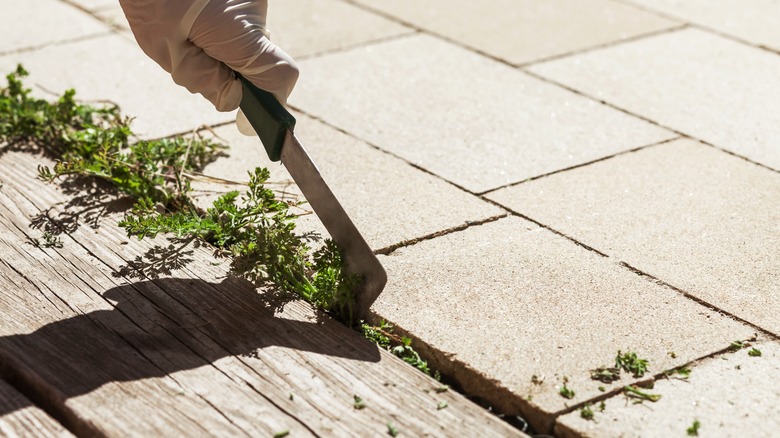
Mariana Serdynska/Shutterstock
Weeds can be a gardener’s nightmare, popping up uninvited and competing with your plants for nutrients and sunlight. Not only do they obstruct the growth of your desired plants, but they also make your garden look untidy. While many commercial herbicides are available, a homemade solution featuring castile soap offers a more eco-friendly way to tackle these nuisances. To whip up your own soap-infused weed killer, combine some vinegar with 1 cup of salt and 1 teaspoon of castile soap. Pour the mixture into a spray bottle, and you’re ready.
Castile soap is vital to making your vinegar-based weed killer more effective. Vinegar works to disrupt the plant’s cellular activity and acidify the soil, inhibiting future growth. However, spraying a vinegar-only solution often sits on the weed’s leaves, minimizing absorption. Adding castile soap changes this dynamic. It weakens a plant’s defenses, allowing treatment solutions to penetrate more effectively. Salt, on the other hand, dehydrates plants, cutting off their water supply and stunting growth.
In short, this treatment offers a more efficient way to reclaim your garden from unwanted plants. However, timing is crucial for the application of this home-brewed herbicide. To prevent dilution and ensure that the vinegar, salt, and castile soap adhere to the weed, try to spray it when there is no chance of rain. Also, remember that you may have to apply this mixture more than once. Persistent weeds often require multiple treatments to fully eliminate them.
Works to absorb nutrients in fertilizers
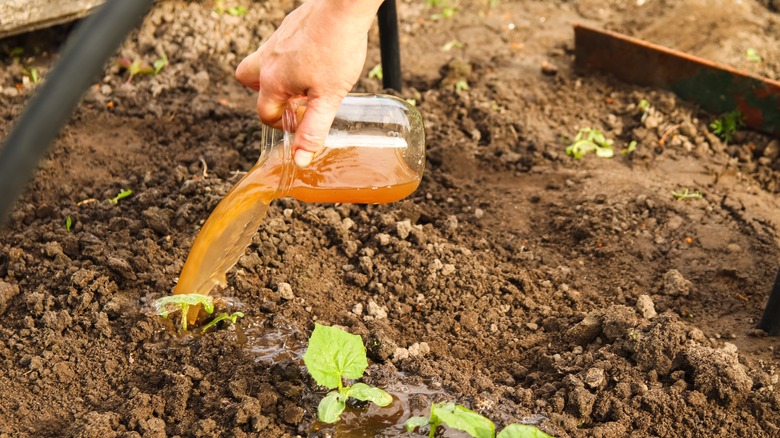
tanitost/Shutterstock
Fertilizing your garden is crucial for lush, healthy plant growth. It provides essential nutrients that the soil might be lacking, allowing your plants to thrive. We’ve already talked about how castile soap acts as a surfactant when dealing with water absorption in soil. Now, let’s explore how this versatile soap also aids in the effectiveness of fertilizers. When you add fertilizers to your garden, the goal is to enrich the soil with nutrients your plants can absorb. The challenge is getting those nutrients to disperse evenly throughout the soil so the roots can access them. Here’s where castile soap comes into play.
Just as it enhances water penetration by breaking down surface tension, castile soap does the same for fertilizers. It makes the soil ready to absorb whatever nutrient mix you’re using, allowing for more even distribution. This ensures the roots have better access to essential nutrients, leading to healthier, more vibrant plants. To take advantage of this benefit, mix 1 tablespoon of castile soap with 1 gallon of water and use it as a base for your homemade fertilizer concoctions. However, a word of caution: Avoid using antibacterial soaps; they can be detrimental to the beneficial microbes in the soil that contribute to plant health and nutrient absorption.
Works as an antidote against poisonous plants
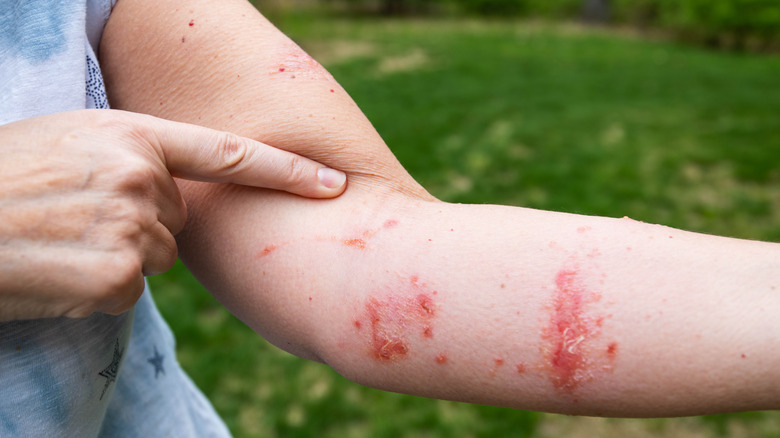
Michael Moloney/Shutterstock
Gardening exposes you to various plants, some of which can be poisonous and cause allergic reactions on your skin. One of the culprits behind those itchy, uncomfortable rashes is urushiol, an oil found on plants like oak, poison ivy, and sumac. That’s why wearing safety gear like gloves and long sleeves is so important when you’re tending to your garden. However, accidents happen. Maybe you didn’t recognize the poisonous plant, or perhaps your glove had a tear in it. If you come into contact with a plant that you suspect is poisonous, castile soap can be a lifesaver. Washing the affected area with soap can mitigate the effects of the urushiol oil. You’ll want to act quickly, though. The sooner you wash off the affected area, the less likely you’ll get a full-blown allergic reaction.
Castile soap is particularly effective because it’s a gentle yet thorough cleanser. Unlike harsher soaps, it won’t further irritate your skin but will effectively remove the offending oil. Some people even swear by using a castile soap that includes tea tree oil, citing its additional antiseptic properties as beneficial in such situations. So, having a bottle of castile soap on hand while gardening is an essential first aid resource. It’s an invaluable tool that addresses multiple gardening challenges, including safeguarding your skin from harmful plants.

